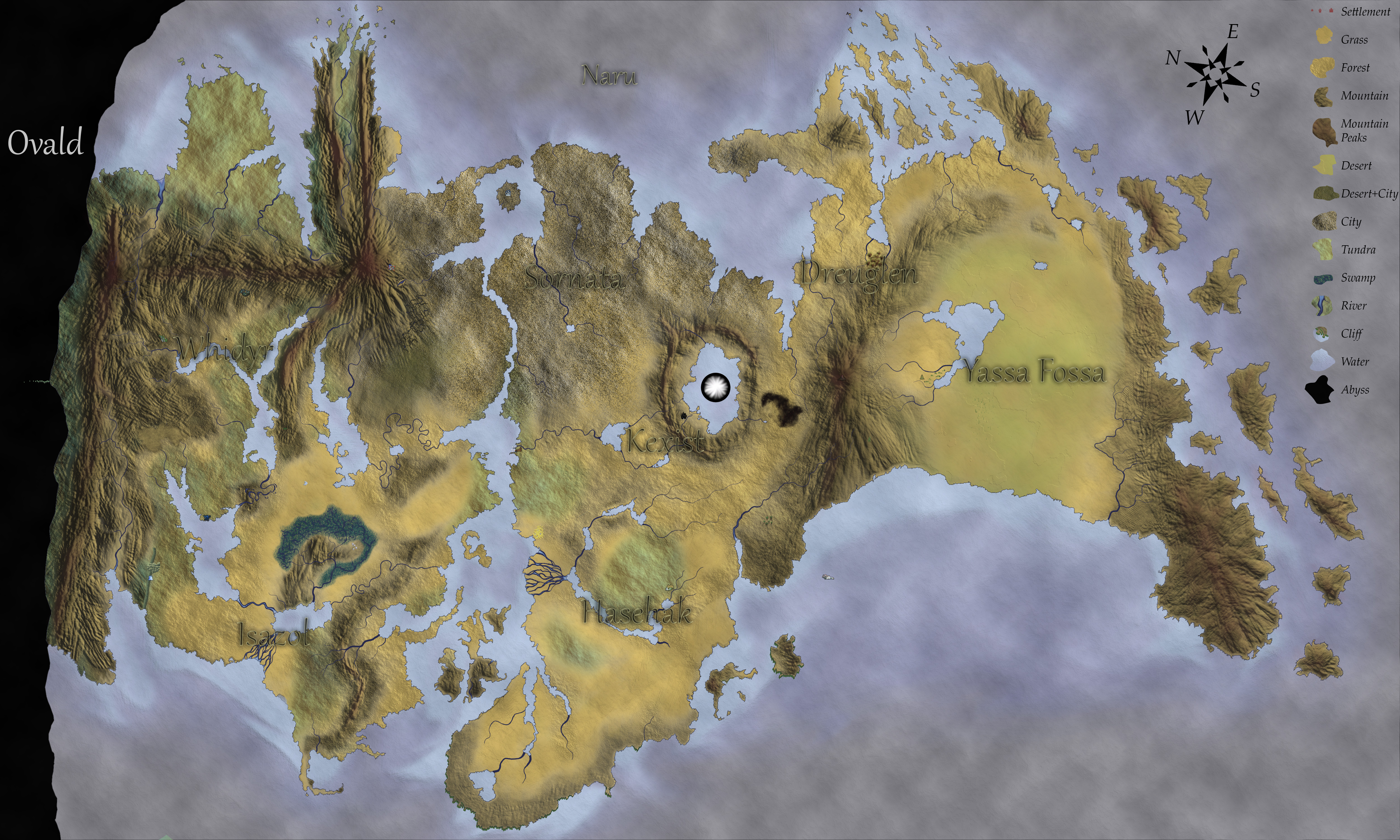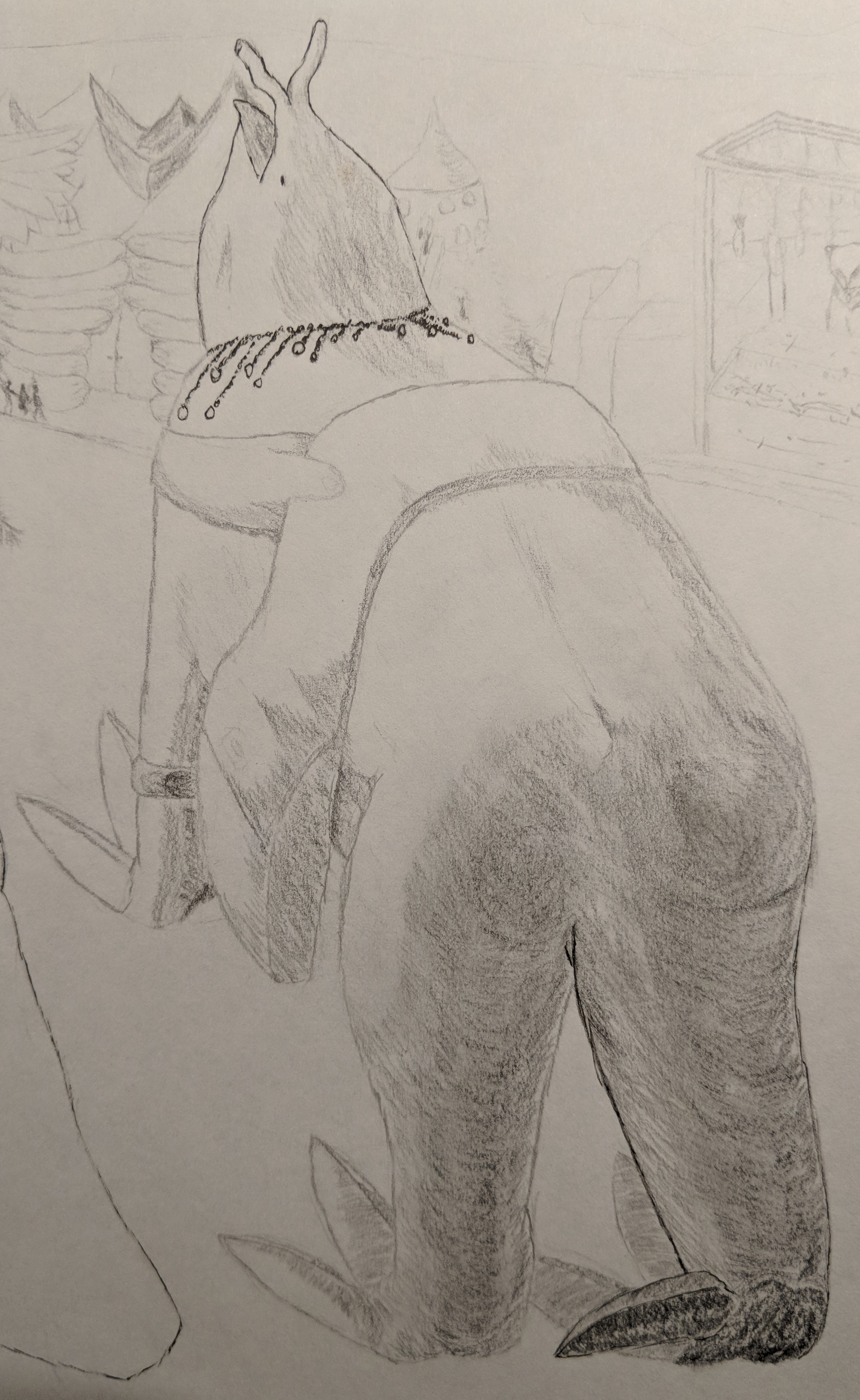Solumkerd
Anatomy & Morphology
Solumkerd have a layer of blubber beneath their thick dark grey to wooden brown hide to fend off the cold of living underground. They also sport a thin coat of fine black fur over most of their body to repel dirt and to see. They do have eyes, but they are underdeveloped, relying more on touch and smell to sense the world around them. Each hair root is highly sensitive to vibrations. All around their cheeks, chin, and forehead they have even thinner hairs that match the size of their body. They use the special whiskers to tell whether they are able to fit into a hole or if they would have to dig it larger.
In more open areas where they don't have many hairs touching ground, such as larger caverns or even the surface, solumkerd use their sense of smell to experience. Their olifactory sense is not the epitome of senses, but it's above average; they are more sensitive to the scent of temperature than of chemicles.
In more open areas where they don't have many hairs touching ground, such as larger caverns or even the surface, solumkerd use their sense of smell to experience. Their olifactory sense is not the epitome of senses, but it's above average; they are more sensitive to the scent of temperature than of chemicles.
Limbs
Solumkerd are quadrupeds with four trunk-thick limbs. Their shoulder and hip joints are very loose, allowing them to splay their limbs out an above their belly; this allows them to spin their limbs in 180 degrees both clockwise and counterclockwise. They use this range of movement to push and pull the ground around them to either dig or build their homes. Their forelimbs are more muscular than their hind, as they use them to break apart stone while their back limbs are primarily used to push back dirt.Claws
The size difference between their fore and hind limbs also applies to their claws, their hind-claws being smaller than the fore-claws. Six claws encircle their palms in two-hundred and seventy degrees; they curve like shovels with pointed, and dangerously sharp, tips used in digging and breaking stone. They're quite large, half the length of their limb and a third as thickHabits
Dietary Needs and Patterns
While this form of filter feeding will sustain them for a time, it is not enough to support them completely. They also hunt near any creature that burrows and graze in foliage-dense caverns. To find their prey they use their fur to feel for movements within the ground, rapidly burrowing towards their prey once they sense them. Their potential meal sense their approach and try to flee, but the solumkerd use their massive claws to pierce and or cut their victim in one swift and calculated stroke. After they dig out their prey, if it is large they use their incisors to cut into it. This will oknly bee during angry fits of hunger, it's much easier to munch on some vines, roots, or sub-terrenaite tree leaves. This is, as long as it's not poisonous, venomous, will not fight back, and does not have too many thorns.
Mating Rituals & Family
They are as liberal with their family admittance as they are with who they breed with. There is little conflict or stigma with who are able mate with who, nothing either sex does, looks like, or represents themselves as affect how attractive they are as a mate. The choice of those who mate comes down to who are in heat at the same time. Both males and females only have select times that they are willing and able to breed, about only once or twice a year.
Solumkerd give birth to one child at a time, in rare cases two but never more. The whole labour will take care of the young until they reach maturity, the two parents not going into heat again while the young grows. The young mature rapidly, being able to breed after their fifth year. The adults consider the child to be as such for many years after, taking so long to reach mental maturity. During the child's upbringing, the parents stays within the center of the labour during rest with other childdren and parents.
Original Ecology & Habitat
Like the Cold
Like most sub-terranian species, they have a defence of blubber against depth's cold. The deeper one goes, the colder it will get, as is the nature of the world's bil core. The harsh cold and underground blizzards are nothing to twirl nostrils at, they find it comfortable and the burning light on the surface painful (it doesn't help they don't have any skin-defense against firey light-rays. it's easier to live on the surface in colder climates, like isazol. Cold boxes aren't just for Isynx.Cave Systems
Solumker use both the natural cave systems around them and create their own. The typically make their homes just off of a large, open, plant-rich cave (some being so large to have rain and other weather). They dig out a complex system of roads, homes, and public areas they use similarly to villages.Hibernation
Solumkerd hibernate, which is unique among Rela. Their hibernation does interfere with their interactions with other species, disappearing for two seasons every year, the dead season and silent season respectively. They all huddle into a large closed-off pocket of air deep within their village, forming a giant mass of sleeping bodies. The children and their parents are kept in the center while those with thicker hide sleep on the outer ring.Hygiene
Bathing: Simple answer, they don’t. That is to say, they don’t actively or purposely clean themselves. The tunnels they dig are only just big enough to fit their bodies, scraping at their calloused hide constantly. This clears away any surface debris.
Subspecies
Amayu
Appearance
Their blubber and overall stature are greater, more adapted to colder, deeper caves. They also have more fur and thicker skin, more used to rubbing against harder and sharper rocks (sometimes ice).Wurya
Appearance
They re smaller and have less blubber and are shover-claws smaller. They have fur patterns in ultra-orange, which is picilular since their poor eyesight doesn't cover that visual range.
Genetic Ancestor(s)
50-250
Size
7-10 meters from extended snout to tail






Comments